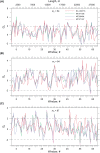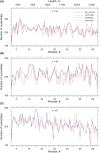Ribonucleocapsid assembly/packaging signals in the genomes of the coronaviruses SARS-CoV and SARS-CoV-2: detection, comparison and implications for therapeutic targeting
- PMID: 32901577
- PMCID: PMC7544952
- DOI: 10.1080/07391102.2020.1815581
Ribonucleocapsid assembly/packaging signals in the genomes of the coronaviruses SARS-CoV and SARS-CoV-2: detection, comparison and implications for therapeutic targeting
Abstract
The genomic ssRNA of coronaviruses is packaged within a helical nucleocapsid. Due to transitional symmetry of a helix, weakly specific cooperative interaction between ssRNA and nucleocapsid proteins leads to the natural selection of specific quasi-periodic assembly/packaging signals in the related genomic sequence. Such signals coordinated with the nucleocapsid helical structure were detected and reconstructed in the genomes of the coronaviruses SARS-CoV and SARS-CoV-2. The main period of the signals for both viruses was about 54 nt, that implies 6.75 nt per N protein. The complete coverage of the ssRNA genome of length about 30,000 nt by the nucleocapsid would need 4.4 × 103 N proteins, that makes them the most abundant among the structural proteins. The repertoires of motifs for SARS-CoV and SARS-CoV-2 were divergent but nearly coincided for different isolates of SARS-CoV-2. We obtained the distributions of assembly/packaging signals over the genomes with nonoverlapping windows of width 432 nt. Finally, using the spectral entropy, we compared the load from point mutations and indels during virus age for SARS-CoV and SARS-CoV-2. We found the higher mutational load on SARS-CoV. In this sense, SARS-CoV-2 can be treated as a 'newborn' virus. These observations may be helpful in practical medical applications and are of basic interest. Communicated by Ramaswamy H. Sarma.
Keywords: COVID-19; SARS-CoV; SARS-CoV-2; genome packaging; helical nucleocapsid.
Conflict of interest statement
No potential conflict of interest was reported by the authors.
Figures






Similar articles
-
Evolving ribonucleocapsid assembly/packaging signals in the genomes of the human and animal coronaviruses: targeting, transmission and evolution.J Biomol Struct Dyn. 2022;40(21):11239-11263. doi: 10.1080/07391102.2021.1958061. Epub 2021 Aug 2. J Biomol Struct Dyn. 2022. PMID: 34338591
-
An in vivo cell-based assay for investigating the specific interaction between the SARS-CoV N-protein and its viral RNA packaging sequence.Biochem Biophys Res Commun. 2019 Dec 10;520(3):499-506. doi: 10.1016/j.bbrc.2019.09.115. Epub 2019 Oct 5. Biochem Biophys Res Commun. 2019. PMID: 31594639 Free PMC article.
-
SARS-CoV-2 N protein coordinates viral particle assembly through multiple domains.J Virol. 2024 Nov 19;98(11):e0103624. doi: 10.1128/jvi.01036-24. Epub 2024 Oct 16. J Virol. 2024. PMID: 39412257 Free PMC article.
-
Properties of Coronavirus and SARS-CoV-2.Malays J Pathol. 2020 Apr;42(1):3-11. Malays J Pathol. 2020. PMID: 32342926 Review.
-
The SARS coronavirus nucleocapsid protein--forms and functions.Antiviral Res. 2014 Mar;103:39-50. doi: 10.1016/j.antiviral.2013.12.009. Epub 2014 Jan 11. Antiviral Res. 2014. PMID: 24418573 Free PMC article. Review.
Cited by
-
Three-Dimensional Visualization of Viral Structure, Entry, and Replication Underlying the Spread of SARS-CoV-2.Chem Rev. 2022 Sep 14;122(17):14066-14084. doi: 10.1021/acs.chemrev.1c01062. Epub 2022 Jul 21. Chem Rev. 2022. PMID: 35863749 Free PMC article. Review.
-
Molecular insight into the specific interactions of the SARS-Coronavirus-2 nucleocapsid with RNA and host protein.Protein Sci. 2023 Apr;32(4):e4603. doi: 10.1002/pro.4603. Protein Sci. 2023. PMID: 36807437 Free PMC article.
-
Unpacking Pandora From Its Box: Deciphering the Molecular Basis of the SARS-CoV-2 Coronavirus.Int J Mol Sci. 2020 Dec 31;22(1):386. doi: 10.3390/ijms22010386. Int J Mol Sci. 2020. PMID: 33396557 Free PMC article. Review.
References
MeSH terms
Substances
LinkOut - more resources
Full Text Sources
Other Literature Sources
Research Materials
Miscellaneous
